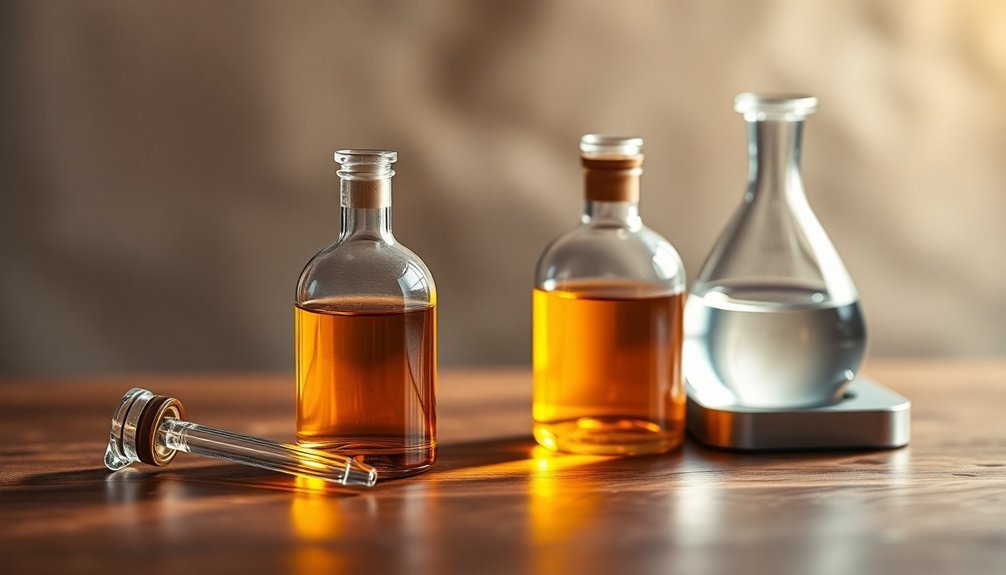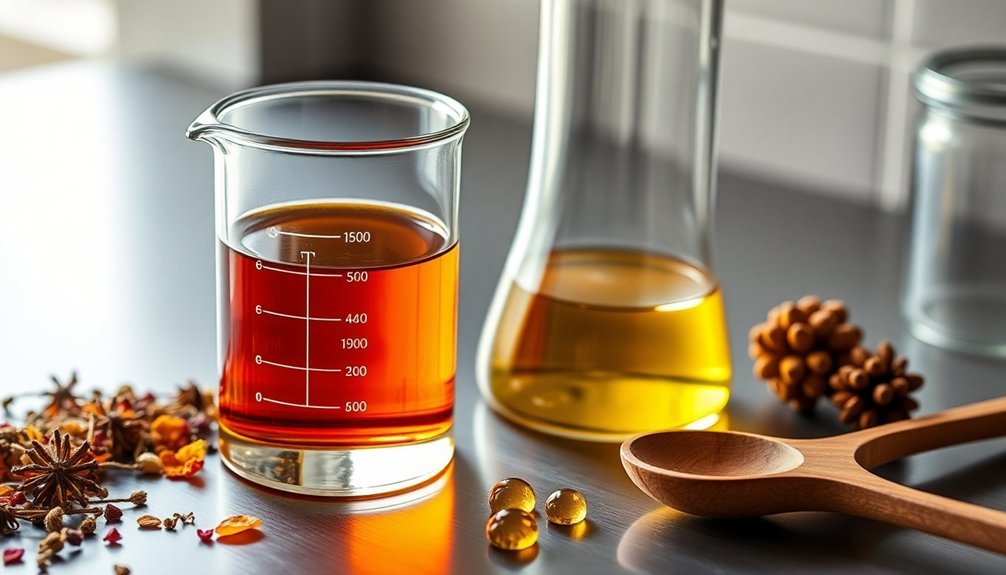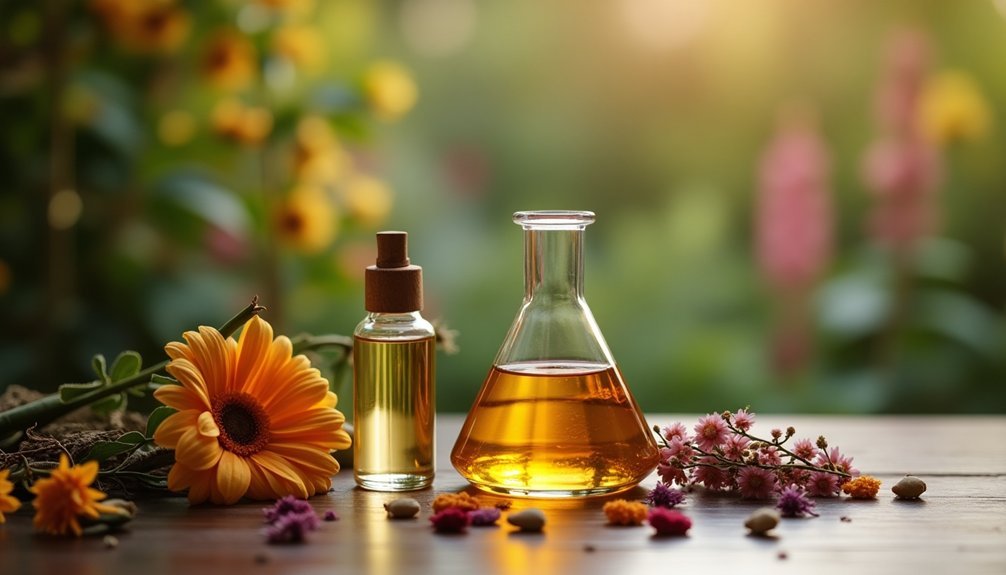When making perfume, you'll want to follow the standard ratio of 20% fragrance oils to 80% perfumer's alcohol for the best results. You can adjust this to 30% oils if you prefer a stronger scent, but don't exceed this limit to avoid skin reactions. Remember to blend your oils using the 30-50-20 rule: 30% top notes, 50% middle notes, and 20% base notes. Mastering these essential ratios is just the beginning of your journey into professional perfume creation.
Understanding Basic Perfume Ratios

Three key components form the foundation of perfume making: fragrance oils, alcohol, and proper ratios.
You'll want to use pure, undenatured perfumer's alcohol to guarantee your scent stays true and avoid potential skin reactions.
For a balanced perfume, stick to the standard ratio of 20% fragrance oils to 80% alcohol. While you can adjust this up to 30% oils for a stronger scent, be aware that higher concentrations may increase the risk of allergic reactions.
Remember to follow the "30-50-20 rule" when combining your fragrance notes: 30% top notes, 50% middle notes, and 20% base notes. Using glass measuring beakers helps achieve precise measurements.
Start by adding base notes to your alcohol first, then layer in the middle and top notes. Always check the IFRA guidelines for safe usage rates of specific fragrances.
Essential Oil Concentration Guidelines
While perfume making focuses on fragrance-to-alcohol ratios, understanding proper essential oil concentrations guarantees safe and effective product formulation.
You'll need to carefully dilute your essential oils to prevent skin reactions and confirm product safety. For perfumes, you can use up to a 5% concentration, but most body care products require lower amounts. When creating facial products, stick to 1% or less dilution, while massage oils work best at 2%. A toxicologist on staff helps ensure the safety of essential oil formulations.
- Never apply undiluted essential oils directly to your skin
- Use precise measuring tools to maintain accurate ratios
- Start with fewer drops and adjust as needed
- Test blends on a small skin area first
- Keep detailed records of your successful formulations
Remember to let your perfume blends rest for 24 hours to allow the scents to properly combine.
Selecting the Right Alcohol Base

When creating perfumes, choosing the right alcohol base greatly impacts your final product's quality and safety. You'll want to use ethanol, specifically perfumer's alcohol, as your primary base since it's olfactorily neutral and evaporates quickly, helping to fix fragrances on the skin. The resulting mixture provides an immediate feeling of freshness upon application.
| Alcohol Type | Characteristics |
|---|---|
| Pure Ethanol | Safest for skin, ideal for perfumes |
| Denatured Ethanol | Cheaper but may cause reactions |
| Perfumer's Alcohol | Specially formulated, best results |
While denatured alcohol might be less expensive, it's best to invest in pure, undenatured ethanol to avoid potential skin reactions. You'll need to maintain proper ratios, typically using 80% alcohol to 20% fragrance oils. Always check IFRA certificates and follow safety guidelines when mixing your perfumes to guarantee a safe, long-lasting product.
Water Content and Dilution Methods
Understanding proper water content and dilution methods builds upon your alcohol base selection to create balanced perfumes.
When working with water-based compositions, you'll typically use about 67% water along with essential solvents like ethanol or dipropylene glycol methyl ether. For accurate dilutions, always use precise weighing methods rather than counting drops.
- Start with a 20% essential oil to 80% alcohol ratio to maintain scent strength
- Choose ethanol as your primary solvent for its mild odor and excellent dissolution properties
- Consider DPG or PG for enhanced stability in water-based formulations
- Optimize fragrance release by selecting odorants based on their water release groups
- Avoid carrier oils unless specifically making oil-based fragrances, as they hinder evaporation
Your dilution method directly impacts the perfume's stability, release profile, and overall performance in both water-based and alcohol-based compositions.
Aging Process and Time Requirements

You'll need to age your perfume for at least three weeks to allow the fragrance components to properly blend and stabilize, though complex formulas may require up to nine months for ideal results.
During the aging process, store your perfume in a cool, dark place away from direct sunlight and temperature fluctuations to maintain its integrity.
The maturation period lets your fragrance develop a smoother, more balanced profile as the top, middle, and base notes harmonize together.
Optimal Aging Duration
The aging process plays an essential role in developing a perfume's final character, much like how fine wines mature over time.
You'll need at least 2-4 weeks for basic maturation, though many fragrances benefit from several months of aging. For best results, blend your fragrance oils for 2-4 weeks before adding alcohol, then let the mixture rest for another month.
- Rich, woody, and resinous blends typically need longer aging periods than lighter, floral scents.
- Alcohol-based perfumes show more improvement with aging than oil-based ones.
- Top notes integrate or fade first, while base and heart notes develop deeper complexity.
- Some fragrances dramatically improve with age, while others remain stable.
- Proper aging eliminates the need for post-purchase "resting" periods.
Storage During Maturation Period
Proper storage during the maturation period can make or break your perfume's development. You'll need to maintain constant conditions to guarantee your fragrance matures correctly. Store your perfume in a cool, dark place at around 60 degrees, away from direct sunlight and heat sources.
Don't keep your perfume in the bathroom, as humidity and temperature fluctuations can disrupt the aging process. Instead, use a closet or cupboard outside the bathroom, and consider using a dehumidifier in humid environments.
Keep your perfume in its original bottle with a tight seal to prevent evaporation and oxidation, and avoid excessive shaking. Place the bottle on a low shelf to prevent accidents, and if you're double-packing for extra protection, use the original box inside an airtight container.
Perfume Note Combinations
Creating successful perfume blends relies on understanding how different fragrance notes interact and complement each other. When you're combining perfume notes, focus on both kindred and complementary scent families to achieve balanced, sophisticated fragrances.
You'll find that notes from neighboring families on the fragrance wheel blend naturally, while those from opposite sides create intriguing complexity.
- Combine woody and amber notes for a warm, harmonious base
- Layer floral middle notes with citrus top notes for fresh, vibrant blends
- Mix oriental base notes with ozonic top notes for mysterious, airy compositions
- Pair herbal middle notes with woody base notes for earthy depth
- Blend complementary families using common notes as bridges between scents
Remember to follow the 20-30-50 ratio rule for top, middle, and base notes while allowing your blend to mature for best results.
Blending Techniques and Measurements

Mastering precise measurements and methodical blending techniques forms the foundation of successful perfume creation.
You'll want to use weight rather than volume measurements for accuracy, as liquid volumes can vary with temperature. Start with a standard ratio of 20% fragrance oils to 80% alcohol for a strong, balanced scent.
When blending, consider vapor pressure to predict how your fragrance will diffuse. Aim for around 0.01 mmHg for ideal longevity.
You'll need to test your blends on fragrance strips and let them mature for several days. Don't forget to keep detailed records of your formulas using recipe cards or spreadsheets.
For non-alcohol bases, you can use fractionated coconut oil at the same ratio, though you'll need to account for reduced diffusion.
Clear your nose with coffee beans between testing to avoid nasal fatigue.
Frequently Asked Questions
How Can I Test My Perfume for Skin Sensitivity Before Regular Use?
You'll need to perform a patch test: apply a small amount of perfume to your inner arm or back, cover it with a bandage, and monitor for any reactions over 48-96 hours.
What Natural Preservatives Can Extend the Shelf Life of Homemade Perfumes?
You can use Vitamin E or rosemary extract as natural antioxidants in your homemade perfumes. Store them in a cool, dark place, and consider adding glycerin at high concentrations for additional preservation benefits.
Can Seasonal Temperature Changes Affect My Perfume's Scent and Stability?
Yes, temperature changes considerably affect your perfume. Heat can make it smell stronger and evaporate faster, while cold weather brings out base notes. You'll notice these changes most during extreme seasonal shifts.
How Should I Properly Clean and Sterilize Perfume Bottles Before Use?
First, clean your bottle with soapy water and a small brush. Then use a vinegar-water solution for oily residues. You'll want to sterilize with either UV light or diluted ethanol before final warm water rinses.
What Are the Best Storage Containers for Essential Oils and Finished Perfumes?
You'll want dark glass or wooden containers with felt lining for essential oils, and tinted glass bottles with atomizers for perfumes. Both should have airtight seals to protect against light and air.
In Summary
You've learned the essential ratios and techniques for creating your own signature perfume. Remember to follow the 15-30% fragrance oil to alcohol ratio for eau de parfum, and don't rush the aging process. Start with small test batches, keep detailed notes of your combinations, and adjust your formulas based on results. With practice and patience, you'll master the art of perfume making and create unique personal fragrances.





Leave a Reply